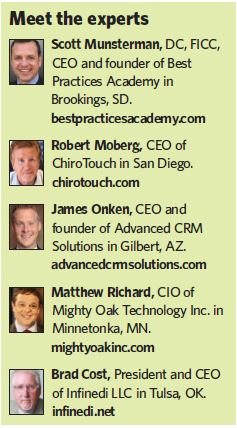To stay competitive, you need to know how to collect chiropractic data, how to use it, and how it can help keep your business viable now and in the years to come.
Technological advances are happening more quickly as new apps, software programs, and hardware flood the market. While most chiropractors would prefer to do the work they were trained to do—chiropractic—to stay in business they also have to keep up with the times.
What the data?
You have access to a lot of information—from your patients, collections, and even your staff. You may not think it’s important to both collect and use this data, but it is, especially with changes coming across the horizon.
“With the advent of the new payment system beginning January 2017, for Medicare, providers will be playing an important role in performing key clinical activities known as quality measures, which will be monitored by third-party payers and rewarded through pay-for-performance models,” says Scott Munsterman, DC. “Clinical data must be collected and reported to help practices achieve a higher rate of reimbursement and better management of the practice’s patient population health.”
The kind of data that chiropractors can collect is, well, a lot. But don’t let it overwhelm you as there are companies and organizations that can collect the data for you. But you need to know what kind of data you can (and should) be examining.
“The amount of data collected by chiropractors who utilize a fully integrated electronic health record (EHR) software system is considerable,” says Robert Moberg, a software specialist. “Basic data collected would include patient contact information, payment and visit history, demographic data such as age, height, weight, etc.
Additionally, critical data as to the diagnosis and results of care—outcome assessment—for each patient is captured.”
Moberg adds that his company alone has about 400,000 patient visits a day going through its systems—collecting such data as demographics, conditions, treatments delivered, outcomes, reimbursement and collections, Current Procedural Terminology (CPT) code used, and so much more.
Munsterman adds that key performance data for chiropractors includes financial, operational, and clinical data. He explains that financial data is your patient accounts receivable in the billing systems administered via your practice management software, in addition to a separate accounting or bookkeeping system that manages the practice’s revenue and expenses, payroll, and pertinent financial reports. Operational data, Munsterman says, comes directly from your practice management soft- ware and tells the story of the statistics in your practices—new patients, patient visits, dollars collected averaged per patient visit or case, charges per patient visit or case, and more.
There are, though, other types of data that you can collect as well.
Customer relationship management (CRM) data should be collected to give you the advantage of creating and maintaining strong relationships with your patients. James Onken, a CRM expert, says, “Chiropractors should be collecting appointment details and patient details—including information such as email, birthdays, as well as relevant dates such as the last visit date and the date of their first visit.”
Now what?
Once you’ve collected all this data, there is quite a lot you can do with it. Matthew Richard explains: “As the CIO of an EHR and practice management software company, I am focused on the story chiropractors can tell about the effectiveness of their care. In the decade that I have been working in this industry, I see clinics gathering and storing their data in very different systems: EHR, billing, paper documents, stand-alone document software, etc. In the age of quality, being able to look at all of that data comprehensively will be the basis of how a chiropractic clinic can demonstrate the effectiveness of their care in a quantifiable way.”
“Collecting data is important. Reporting on it, critical,” says Moberg. “Begin to report on it as you do when examining collections again, looking at patient visit average (PVA), checking on missed appointments, and so on.
Then, support a collective movement toward repurposing clinical data for reinforcing doctors, the current and future patients, and the insurance regulators of the amazing successes being accomplished in chiropractic offices.”
“First and foremost, chiropractors can use the data collected to more efficiently run their practices by analyzing appointment efficiency, PVA, insurance collections, and other aspects of practice management,” Moberg says. “We also have to look at all of this in the larger landscape of the healthcare profession. Collecting and utilizing data in the practice used to be a luxury—now it’s a requirement. Payers are moving to an outcome-based reimbursement versus fee-for-service, and the only way to demonstrate outcomes is through good data. So, ultimately, getting paid will be directly linked to data.”
“The healthcare world is rapidly moving to performance-based metrics,” says Brad Cost, an expert in the healthcare and data analytics industry. “Programs like MIPS, APM, ACOs, IPAs, etc., are already starting to drive the healthcare world … I believe that it is very hard for providers to do analysis and then utilize their data; they’re just too busy. Providers need to get involved in external companies—such as clearinghouses and state associations that are helping the profession collect and organize their data in a pro-advocacy effort.”
Cost explains that the claims clearinghouse is most likely the largest repository of data because it involves all the information from the software systems of providers across the U.S. and then across the entire spectrum of specialties. “This level of collection has one of the greatest unbiased datasets that exists. Although it does not have clinical information, many conclusions can be derived from the claim and electronic remittance advice (ERA) data,” Cost says. “The financial aspects are still one of the most important components of healthcare data. Some clearinghouses are developing systems like patient and provider registries that will combine both national financial and clinical data into a comprehensive patient healthcare cycle.”
Onken notes that using the data they collect is where many chiropractors fall short: “The largest companies are leveraging their data and making business decisions with it. They have monopolized CRM-related technologies for many years. Times have changed.” He says CRM companies can help chiropractic practices leverage the data they collect for reporting and analytics to make better business decisions and communicate with their patients more effectively, which will ultimately create a better patient-doctor relationship and increase revenue.
Giving you an edge
Using the data you collect can help you do many things, including work more efficiently, collect more money, and gain an edge on your competitors.
“The ultimate goal of efficiency is to improve how a doctor and staff spend their time. Freeing up time to focus on improving patient care is critical, and improved patient care is the ultimate driver of practice success,” Moberg says. “Rather than spending time on documentation, billing, collection, and other administrative tasks, data can empower the practice to automate those tasks currently being done manually.” He points out that
automating those tasks and simultaneously having immediate access to the data associated with each patient can be transformative for a practice. “In terms of competitive advantage, a doctor running a modern, data- empowered practice makes a much better impression on a patient than does one still using manual processes,” he says.
And patients feel comforted when they see their healthcare provider is running a technologically advanced practice. It has a positive effect on patient compliance, and it also increases the likelihood of the patient referring others to the practice.
Moberg says most patients today are tech-savvy, and they are surrounded in their home and work environments by technology. Because they are constantly exposed to innovations, from health apps on their smartphones to health- tracking apps on their wrists, they will expect the same in chiropractic offices.
So how do they see your office? “What’s their impression?” Moberg asks. “Are they handed a clipboard and pen for intake or an electronic tablet? Can they check in online or set appointments on a mobile app?” These examples begin to form the opinion as well as confidence level that patients will have when they assess your practice.
Munsterman says you must have the right system in place to ensure the financial data you gather will keep revenue flowing through your office. A daily or weekly review of operational statistics helps chiropractors watch for trends in their practices. But what’s really taking on a new level of importance is clinical data.
“First, clinical data will determine how much more you will be paid in the future and, secondly, it will open up new opportunities for expanding service lines in the practice,” Munsterman says. For example, by monitoring a patient’s body-mass index you open up the opportunity to talk to the patient about nutrition, exercise, diet, etc. You can then follow up with a health-coaching session, as well as a well-being care plan.
“There are many quality measures in the new value-based payment system that give opportunities like this for the doctor to work with the patient and act on what they have learned about the patient through this measure,” Munsterman says.
“Chiropractors are uniquely trained to play a big role in this new focus on wellness and improving the healthcare of the population. The DC has an edge over other provider types in the area of a natural, holistic clinical approach, which is strengthened through their clinical skills in primary health services.”
Using data most efficiently can also bring in money in other ways. “One of the great avenues of data is using it to bring about change within the insurance world,” Cost says. “Providers that are organizing in groups, like Independent Physician Associations, which are mostly owned by the chiropractic state associations, can utilize their data in an organized way that is helping insurance payers understand chiropractic. This methodology has been successful in many states, which has led to higher reimbursements.”
In terms of CRM, there is even more you can get from the data. “Imagine emails that are triggered when a patient has not been to visit in 30 or 45 days. Imagine automated birthday emails, referral campaigns, and a newsletter that are all triggered by data. What if you understood where every patient came from, how much they spent, and what types of treatments they were receiving?
Chiropractors would be able to market better, educate better, and provide a better experience for the patient,” Onken says. These types of technologies exist right now and can give your practice a tremendous advantage.
Hurdles ahead
The biggest challenge chiropractors face most likely comes in the form of getting in the habit of using the tools made to both collect and use the data, Moberg says. “But once data is incorporated into the daily operations of a practice, they would never again practice without it,” he says.
Some chiropractors simply don’t want to automate and collect data. Munsterman says that some have told him that they plan on riding out the next five to 10 years without upgrading and then retiring. But, as he explains, that will prevent them from selling their businesses. A new doctor coming out of school won’t want to purchase a practice that isn’t up-to-speed on electronic changes and data collection.
Many of the experts interviewed agree that chiropractors need to begin using a great EHR system. “Not all EHR companies are created equal or have roots within chiropractic,” Moberg warns. Be sure to research different companies and systems before making your decision.
“Without making a change,” Cost says, “providers will be forced to become a cash practice or retire.”
The biggest rewards
Cost says collecting and using data opens a new world that can lead to better patient outcomes, more efficient business practices, greater patient safety, and a broader spectrum of patients who understand and utilize chiropractic services.
“Ultimately the biggest reward comes in the form of practice success, defined specifically by improved patient care and increased patient compliance. There is also the peace of mind that comes from knowing that your documentation is rock-solid, and where the worry of an audit is dismissed because you run a modern healthcare practice,” Moberg says.
“Without a doubt, data gives you clarity, infrastructure, and organization from a reporting and analytics perspective,” Onken says.
“Collecting data and acting upon it will show your value as a clinician and as a practice to everyone, all on a level playing field with other provider types. All clinicians, no matter the provider type, will be subject to the same set of requirements in the value-based payment system,” Munsterman says. “This presents a unique opportunity for the chiropractic profession. Once good systems are in place, monitoring the performance in these key areas becomes effortless. But the key is to get the right systems in place in the practice so you can keep your focus on patient care.”
 Michele Wojciechowski is an award-winning freelance writing living in Maryland. She is also author of the humor book Next Time I Move, They’ll Carry Me Out in a Box. For more information and to contact her, visit wojosworld.com.
Michele Wojciechowski is an award-winning freelance writing living in Maryland. She is also author of the humor book Next Time I Move, They’ll Carry Me Out in a Box. For more information and to contact her, visit wojosworld.com.


